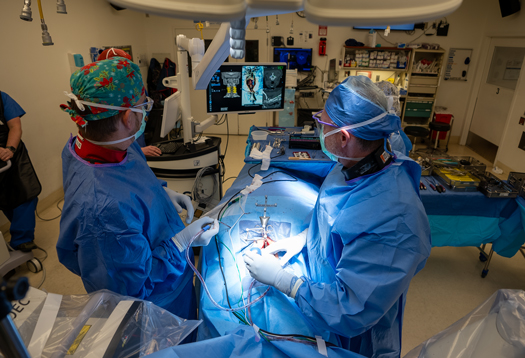

categories:
When a piece of hardware – like a screw – needs to be inserted into a patient’s spine, it’s important that it is placed in precisely the right spot.
“The margin for error is very, very small when inserting instrumentation into the spine. One to two millimeters can make a huge difference as to where you put a screw into the spine,” said neurosurgeon Dr. Raymond Tien.
Now, thanks to donors to St. Charles Foundation, spinal surgeons in Central Oregon are the first in the state to have access to a new, state-of-the-art spinal navigation system to help ensure that spinal surgeries performed at St. Charles are incredibly accurate. The Seaspine 7D spine navigation system arrived this fall and it allows surgeons to see the spine in three dimensions while inserting a piece of hardware.
Tien just used the system for the first time to place hardware in the spine of a patient.
“The procedure went perfectly and faster than it would have gone previously. It’s eye opening how accurate this system is and how easy it is to use,” said Tien.
Patients may need this kind of procedure due to a degenerative or congenital condition or medical trauma, like a fall or car crash. When placed correctly, hardware can help stabilize an unstable spine.
For the past 20 years, surgeons performed spinal surgeries using an X-ray unit in the Operating Room to help them visualize the anatomy. Tien says surgeons took many X-rays of the spine to create as complete a picture as possible. However, he says, the two-dimensional images are not as accurate as 3D images – and the process exposed everyone in the room to a lot of radiation.
With the new system, patients get a high-resolution CT scan prior to surgery. That scan is uploaded to the computer as a reference. Surgeons then place a marker on the patient’s spine that a camera can see. The navigation system has an array of lasers and light-emitting diodes that take a flash photo of the marker exposed in the spine. With those images, surgeons then have an accurate 3D model of a patient’s spine.
“We can see directly on the computer where we are touching and see in very high fidelity where we are inserting the hardware and make adjustments on the fly,” said Tien. “This tool provides us an incredible level of accuracy and precision.”
St. Charles Foundation Executive Director Jenny O’Bryan says this piece of equipment is the largest investment the organization has made this year – spending nearly $700,000 to bring the Seaspine 7D spinal navigation system to Central Oregon.
topics in this article